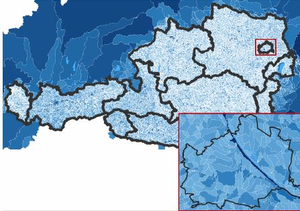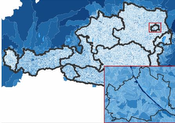Information
- Publication Type: Master Thesis
- Workgroup(s)/Project(s):
- Date: October 2020
- Date (Start): 20. January 2020
- Date (End): 13. October 2020
- TU Wien Library:
- Second Supervisor: Daniel Cornel
- Diploma Examination: 13. October 2020
- Open Access: yes
- First Supervisor: Eduard Gröller

- Pages: 107
- Keywords: View-dependent Visualization, Vector Data Rendering
Abstract
The accurate visualization of huge amounts of georeferenced vector data on heightfields in real-time is a common problem in the field of geographic information systems (GIS). Vector data usually consist of lines and polygons, which represent objects such as roads, rivers, buildings, and parks. The interactive exploration of these vector entities in large-scale virtual 3D environments and the resulting large zoom range pose an additional performance challenge for their visualization. Ensuring clear visibility of all objects of interest in overview and of their details in close-up views is diÿcult in such large-scale environments.
In this thesis, a screen-based visualization method of vector data is proposed, which combines two di˙erent approaches, a static and a dynamic approach, to control the behavior and the visibility of the corresponding vector entities. The vector data can represent real-world objects and to preserve their relative size to the rest of the 3D world, a constant object size is used for the static approach. But, this static behavior can cause vector entities to disappear when zooming out. Since lines are especially a˙ected due to their small width, the dynamic approach scales them according to the current view in order to be clearly visible even from far away.
The evaluation results show that both screen-based visualization approaches can be applied in real-world use cases of a geospatial decision support system with large-scale environments and vector data consisting of several millions of vertices and still provide real-time performance. The results also highlight that the proposed screen-based visualization method produces larger render overheads compared with a volume-based visualization, but for large vector data sets, the new method outperforms it.
Additional Files and Images
Additional images and videos
Additional files
Weblinks
BibTeX
@mastersthesis{zechmeister2020,
title = "Interactive Visualization of Vector Data on Heightfields",
author = "Silvana Zechmeister",
year = "2020",
abstract = "The accurate visualization of huge amounts of georeferenced
vector data on heightfields in real-time is a common problem
in the field of geographic information systems (GIS). Vector
data usually consist of lines and polygons, which represent
objects such as roads, rivers, buildings, and parks. The
interactive exploration of these vector entities in
large-scale virtual 3D environments and the resulting large
zoom range pose an additional performance challenge for
their visualization. Ensuring clear visibility of all
objects of interest in overview and of their details in
close-up views is diÿcult in such large-scale environments.
In this thesis, a screen-based visualization method of
vector data is proposed, which combines two di˙erent
approaches, a static and a dynamic approach, to control the
behavior and the visibility of the corresponding vector
entities. The vector data can represent real-world objects
and to preserve their relative size to the rest of the 3D
world, a constant object size is used for the static
approach. But, this static behavior can cause vector
entities to disappear when zooming out. Since lines are
especially a˙ected due to their small width, the dynamic
approach scales them according to the current view in order
to be clearly visible even from far away. The evaluation
results show that both screen-based visualization approaches
can be applied in real-world use cases of a geospatial
decision support system with large-scale environments and
vector data consisting of several millions of vertices and
still provide real-time performance. The results also
highlight that the proposed screen-based visualization
method produces larger render overheads compared with a
volume-based visualization, but for large vector data sets,
the new method outperforms it.",
month = oct,
pages = "107",
address = "Favoritenstrasse 9-11/E193-02, A-1040 Vienna, Austria",
school = "Research Unit of Computer Graphics, Institute of Visual
Computing and Human-Centered Technology, Faculty of
Informatics, TU Wien",
keywords = "View-dependent Visualization, Vector Data Rendering",
URL = "https://www.cg.tuwien.ac.at/research/publications/2020/zechmeister2020/",
}

 image
image Master Thesis
Master Thesis Poster
Poster


